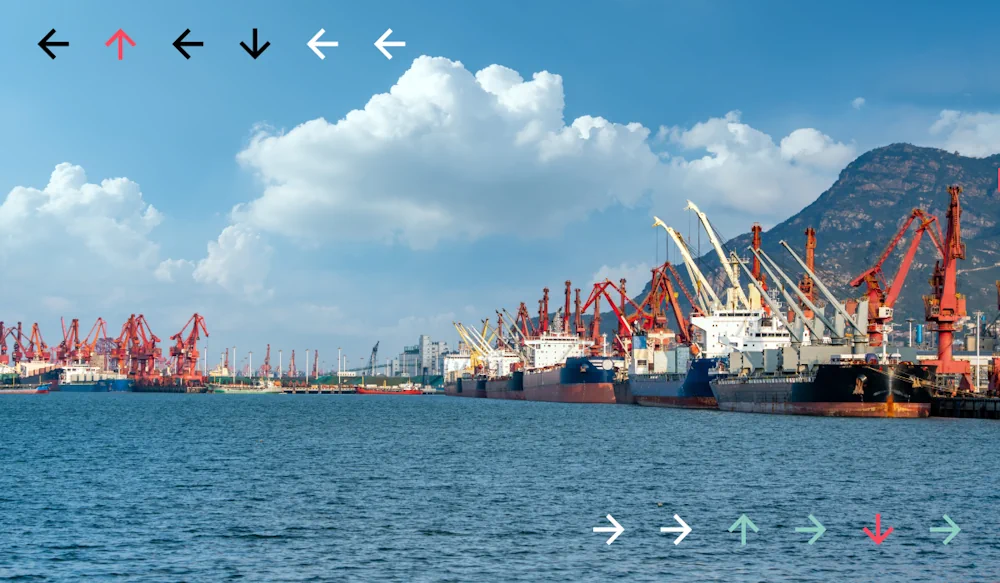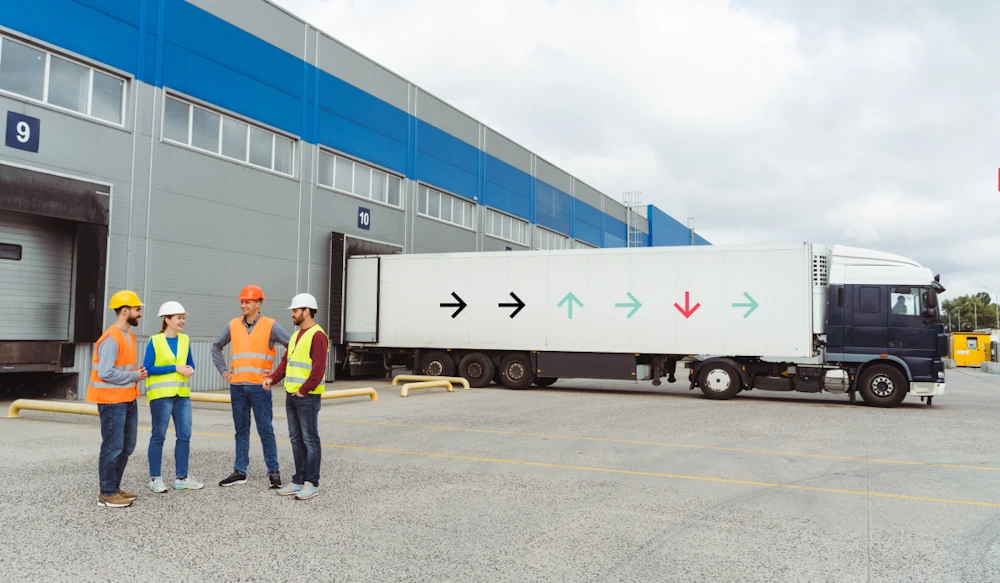How the U.S.-EU Tariff Clash Is Shaking Up Trans-Atlantic Freight Forwarding

The trade bond between the United States and the European Union hit rough waters in 2025, thanks to President Donald Trump’s renewed push for tariffs. Announced on February 26, 2025, the White House’s intention to impose a 25% Trump tariffs on EU imports has sparked a shift, rattling freight forwarding, supply chains, and the broader logistics world across the Atlantic. According to the American Chamber of Commerce to the EU, it’s a high-stakes clash threatening a $9.5 trillion yearly commercial relationship, encompassing trade and investments.
A familiar struggle is at the heart of the dispute—protectionism versus free trade, national interest versus economic partnership. This article explores why Trump wants tariffs, what tariffs did trump impose, how the tariff war unfolded, and the EU’s response. With both sides refusing to back down, the standoff is reshaping trade dynamics, raising business costs, and putting the future of U.S.-EU economic relations at risk.
Table of Contents:
- Trump Tariffs Explained: Why the U.S. and EU Are Locking Horns
- Freight Forwarding Caught in the Crossfire
- Supply Chains Scramble to Adapt
- Ripples Across Global Logistics
- What’s Next for Freight?
- SYNEX Logistics: Navigating the Storm
- Conclusion
Trump Tariffs Explained: Why the U.S. and EU Are Locking Horns
The US tariff war kicked off earlier this month with the reinstatement of Section 232, when Trump imposed 25% tariffs on steel and aluminum imports. This builds on recent U.S. trade measures, including 25% tariffs on imports from China, Mexico, and Canada and a further 10% hike on Chinese goods. The Trump steel tariffs alone hit €28 billion ($29.3 billion) worth of EU exports, per European Commission data.
The broader 25% tariff threatens the EU’s $544 billion in goods exported to the U.S. in 2023. At the press conference, Donald Trump asserted, “The European Union was established to disadvantage the United States,” a claim EU leaders have fiercely rebutted. He’s also threatened 200% tariffs on European alcoholic products in retaliation to the EU’s 50% duties on American whiskey, a move European producers warn could shut them out of the U.S. market entirely. Compliance with all rules and regulations during the delivery of excise goods is essential to ensure the transportation process is legitimate, and SYNEX Logistics is an expert in this field.
The EU isn’t backing down. European Commission President Ursula von der Leyen responded, “I deeply regret the U.S. decision to impose tariffs on European steel and aluminum exports. Tariffs are taxes—bad for business, worse for consumers. Unjustified tariffs on the EU will not go unanswered—they will trigger firm and proportionate countermeasures.”
On March 12, the European Commission detailed retaliatory EU tariffs on the USA on $26 billion in U.S. goods—think bourbon, jeans, motorcycles, and peanut butter—set to roll out in two phases, starting April 1 and April 13. Polish Prime Minister Donald Tusk, whose country holds the EU’s rotating presidency, took to social media: “The EU wasn’t formed to screw anyone. It was formed to maintain peace, to build respect among our nations, to create free and fair trade, and to strengthen our transatlantic friendship.” Spanish Prime Minister Pedro Sánchez added, “The European Union was not created against anyone. It was created in favor of multilateralism and understanding between countries.”
The stakes are high. In 2024, U.S.-EU goods trade hit $975.8 billion, with U.S. exports at $370.2 billion and imports at $605.8 billion, leaving a $235.6 billion U.S. trade deficit that Trump frequently cites. Add the U.K., and U.S.-Europe goods trade reached a record $1.3 trillion, with services trade topping $750 billion. A trade war between these giants—who together account for 33% of global trade—could disrupt cross-border investments, spike costs, and strain diplomatic ties.

Freight Forwarding Caught in the Crossfire
As U.S. and EU trade tensions escalate, the impact is rippling far beyond government boardrooms and into the heart of global supply chains. For companies moving goods across the Atlantic, the new Trump tariff war isn’t just about higher costs—it’s reshaping how they ship, store, and deliver products.
- Customs Chaos. The new levies and similar USA tariffs on Mexico and Canada mean stricter border checks.
- Route Remapping. Companies are rerouting cargo through third countries or less-tariffed ports to dodge costs. It’s a logistical jigsaw—longer trips, but potentially cheaper.
- Bonded Warehouses Boom. According to a German Marshall Fund report, demand for bonded storage—where goods sit tariff-free until sold—has surged 22% in the last quarter as firms delay duties.
- Freight Rate Rollercoaster. Uncertainty is driving shipping costs wild. An increase in container tariffs could profoundly impact trade volumes, reducing global container traffic growth by 0.5%.
With no end to the tariffs Trump is imposing, businesses on both sides of the Atlantic must adapt fast or fall behind. Agility, creativity, and careful strategy are becoming just as valuable as the goods they ship. SYNEX Logistics offers maritime freighter routes to different countries in the world and always finds the best and most beneficial solutions.
Supply Chains Scramble to Adapt
Businesses are rewriting their playbooks to survive: they must rapidly rethink their strategies in response to the escalating tariff trade war. Companies should actively diversify their networks, looking beyond the U.S. and EU to partners in Asia, Vietnam, and Canada to bypass rising Trump EU tariffs. This shift mirrors moves by global giants like Apple, which has gradually relocated parts of its production outside China since earlier trade disputes.
Meanwhile, the EU fast-tracks integration with Latin America. It is trying to reduce its dependence on the two leading global powers, the U.S. and China, and accommodate geopolitical reconfiguration and the uncertainty and risks of a second Donald Trump presidency. At the same time, U.S. manufacturers do not plan to move operations from Mexico. Despite Mexico facing its own tariff challenges, its proximity to the U.S. and existing trade frameworks make it increasingly attractive.
History suggests that while tariffs initially create economic friction—raising prices and disrupting supply chains—markets eventually adjust. SYNEX helps businesses stay ahead of global trade turbulence with smart routing, flexible warehousing solutions, and deep expertise in customs management. This might be extremely important when delivering food products that require compliance with specific conditions and regulations. We provide guarantees and insurance on an individual basis.
Ripples Across Global Logistics
As the U.S.-EU trade conflict deepens, the shockwaves are felt far beyond boardrooms and government offices. The real battleground is global supply chains — where ports, shipping routes, and corporate investments face mounting pressure.
- Port Pileups. Hubs are choking on rerouted shipments.
- Trade Lane Twists. According to the European Commission, trade with Southeast Asia is exceeding €250 billion as firms pivot from old patterns. ASEAN has emerged as the EU’s third-largest trading partner.
- Cost Creep. Trump’s fines target Chinese-built container ships at U.S. ports with $1.5M-$3.5M per-call penalties. Costs hit shippers hard, threatening smaller carriers like ACL with market exit.
- Investment Risks. With Europe receiving more U.S. direct investment than all other regions combined—and European firms driving nearly two-thirds of U.S. foreign investment—Trump tariffs threaten trillions.
This is no longer just about trade policy but a survival strategy for global businesses. As supply chains grow more fragmented and unpredictable, companies that move fast, adapt smartly, and partner with the proper logistics experts. SYNEX Logistics provides comprehensive air transportation services to fulfill customer tasks when maritime ports are unavailable.

What’s Next for Freight?
The future of transatlantic trade hangs in the balance, with two sharply different scenarios emerging. On the one hand, there is still room for diplomacy. A potential U.S.-EU agreement could dial down Trump tariffs in 2025 and allow global freight flows to gradually return to their previous patterns. Such a deal would ease the pressure on supply chains and prevent further disruption to industries already struggling with mounting costs and uncertainty.
Yet, businesses should prepare for a longer and rougher road. Higher operational costs and fragmented supply chains could become the new normal if EU Trump tariffs remain or even escalate. Historical patterns suggest that while the initial shock of tariffs may rattle global trade, markets tend to stabilize over time.
SYNEX Logistics: Navigating the Storm
Amid this escalating tariff storm, having a reliable logistics partner isn’t just helpful — it’s essential. SYNEX Logistics is stepping up to help businesses navigate the new trade realities with innovative, flexible solutions designed to minimize risk and control costs.
With deep expertise in customs regulations across the U.S., EU, and Canada, SYNEX helps clients stay compliant and avoid costly delays. Its multimodal shipping strategies—blending sea, air, and rail—are built to outmaneuver steep tariffs and keep supply chains moving. More than 90% of cargo in the world is delivered by sea. Maritime transportation is one of the leading directions at SYNEX Logistics. The company also has its own Air Delivery Department operating all over the world. Moreover, the highly skilled SYNEX Logistics team is an expert in delivering oversized cargo when customers need special solutions.
Conclusion
Trump’s 2025 tariff revival—starting with steel and aluminum and escalating to a 25% EU-wide levy—has turned down transatlantic freight forwarding. Logistics costs are climbing fast. U.S. markets tanked after the latest announcements, with automakers warning of price hikes within days.
The coming months will test the resilience of U.S.- EU relations and the flexibility of global supply chains. Whether through diplomacy or continued escalation, businesses on both sides of the Atlantic are bracing for volatility. One thing is sure: in this new era of economic confrontation, companies that stay agile, diversify their supply networks, and partner with experienced logistics providers will be best positioned to weather the storm.
Teaming up with pros can turn this situation into a chance to rethink and rebuild smarter. The trade winds are shifting—it’s time to adjust the sails. Call us today to learn about our services worldwide and to adjust the sails together.




